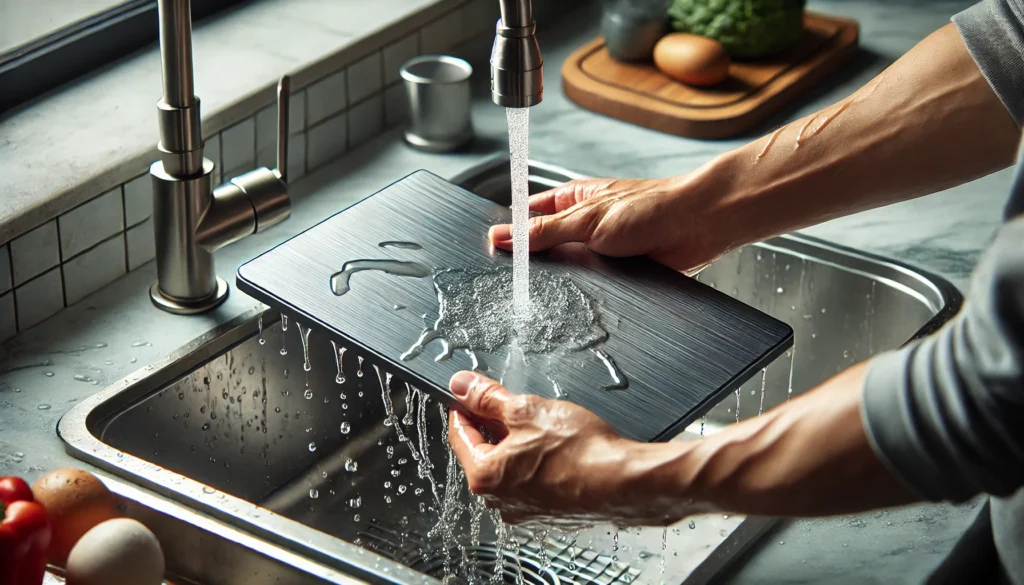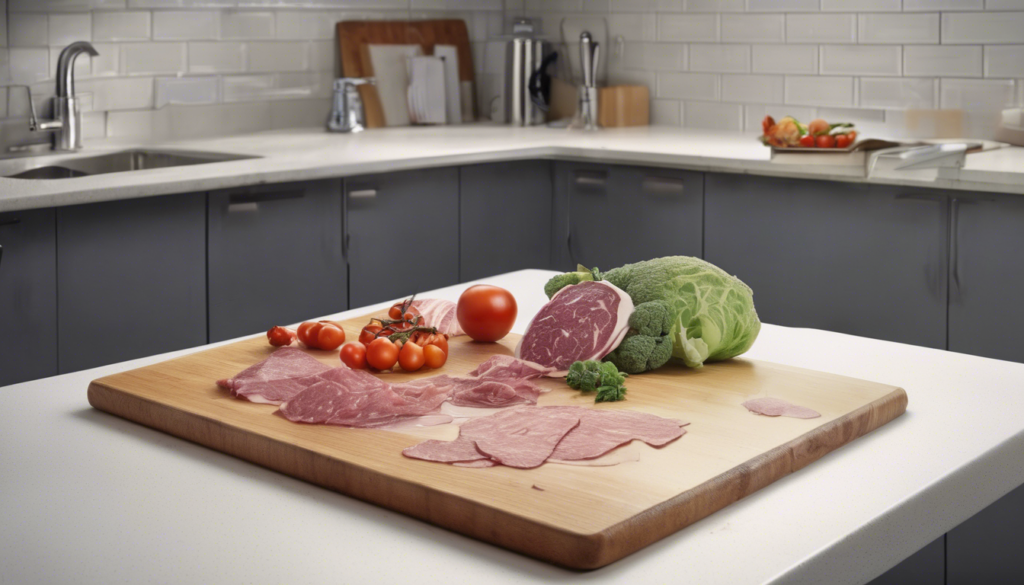Food safety is a crucial part of maintaining a healthy kitchen. One of the biggest risks in food preparation is cross-contamination, which occurs when harmful bacteria transfer from one food item to another, potentially leading to foodborne illnesses. Choosing the right cutting board can significantly reduce this risk. A titanium cutting board offers a hygienic, durable, and easy-to-clean solution for a safer cooking experience.
1. Understanding Cross-Contamination
Cross-Contamination is A Hidden Danger in the Kitchen. Cross-contamination occurs when harmful bacteria or microorganisms transfer from one surface to another, potentially leading to foodborne illnesses. Understanding how it happens is crucial to preventing it in your kitchen. There are three primary ways cross-contamination can occur:
- Direct Contamination – This happens when raw foods, such as meat, poultry, or seafood, come into direct contact with ready-to-eat foods like fruits, vegetables, or cooked meals. For example, placing raw chicken on a plate and then using the same plate for fresh salad without washing it can result in dangerous bacterial transfer.
- Indirect Contamination – Bacteria can spread through contaminated kitchen tools, surfaces, or unwashed hands. Using the same cutting board for raw and cooked foods without cleaning it properly allows bacteria to transfer from raw meat to other ingredients, increasing the risk of contamination. Even kitchen sponges, knives, and countertops can contribute to this form of contamination if not sanitized regularly.
- Airborne Contamination – Tiny droplets from contaminated food or surfaces can become airborne and settle on other foods, especially in enclosed kitchen spaces. This often occurs when handling raw meat or seafood, particularly if juices splash onto surrounding areas or if food particles become airborne during cooking.
To reduce the risks associated with cross-contamination, maintaining a clean and hygienic kitchen is essential. One of the best ways to prevent bacterial transfer is by using a non-porous, bacteria-resistant cutting board. Traditional wood or plastic boards can absorb moisture and develop deep cuts where bacteria thrive. Instead, investing in a high-quality, hygienic cutting board, such as a Titanium Cutting Board, ensures a safer and cleaner cooking environment.
2. Why Titanium Cutting Boards Are the Best for Food Safety
Food safety is a top priority in any kitchen, and the type of cutting board you use plays a crucial role in preventing cross-contamination. A titanium cutting board offers a hygienic and durable solution that significantly reduces the risk of bacterial transfer. Its unique properties make it one of the safest choices for food preparation.
- Non-Porous Surface – One of the biggest drawbacks of wood and plastic cutting boards is that they can absorb liquids and food particles, creating an environment for bacteria to thrive. Titanium is completely non-porous, meaning it does not trap moisture or allow bacteria to penetrate its surface. This makes it an excellent option for keeping your food safe.
- Highly Durable – Many cutting boards develop deep scratches and grooves over time, which can harbor bacteria and make cleaning difficult. Titanium is incredibly strong and resistant to knife marks, ensuring a smooth and sanitary surface after every use. Unlike wood, it will not crack or warp, and unlike plastic, it won’t degrade over time.
- Easy to Clean – Maintaining hygiene in the kitchen is effortless with a titanium cutting board. It can be quickly washed with soap and water or placed in the dishwasher for a thorough clean. Unlike wooden boards that require regular oiling or plastic boards that stain easily, titanium remains pristine with minimal maintenance.
- No Risk of Microplastic Contamination – Plastic cutting boards wear down with use, releasing tiny microplastics into food that may pose health risks. Titanium remains intact, ensuring that no harmful particles end up in your meals. It’s a safer and more sustainable alternative for food preparation.
- Odor and Stain Resistant – Some foods leave behind strong smells or unsightly stains on cutting boards. Titanium’s non-porous surface prevents food odors and discoloration, keeping your kitchen fresh and clean. Whether you’re chopping garlic, cutting raw meat, or slicing colorful fruits and vegetables, a titanium board remains spotless.
By choosing a titanium cutting board, you are investing in a safer, cleaner, and more hygienic food preparation experience. It is an essential tool for any kitchen that prioritizes food safety and efficiency.

3. Best Practices to Prevent Cross-Contamination
Even with the advanced hygiene benefits of a titanium cutting board, following proper food safety practices is essential to ensure a clean and bacteria-free kitchen. Here are the best strategies to prevent cross-contamination during food preparation:
- Use Separate Cutting Boards – One of the most effective ways to prevent cross-contamination is to use different cutting boards for different food groups. Dedicate one board specifically for raw meats, poultry, and seafood, and another for vegetables, fruits, and cooked foods. This prevents harmful bacteria from raw foods from transferring onto ready-to-eat items. A titanium cutting board is versatile enough to handle all food types, but using multiple boards further enhances food safety.
- Wash Hands Frequently – Bacteria can spread easily from your hands to your food, utensils, and kitchen surfaces. Always wash your hands with soap and warm water before and after handling raw meat, seafood, or poultry. Additionally, clean your hands after touching any unclean surfaces, such as trash bins or raw egg shells.
- Sanitize Cutting Boards After Use – Even though titanium cutting boards are non-porous and resistant to bacterial buildup, regular cleaning is still necessary. Wash the board with hot water and dish soap after every use, or use a food-safe disinfectant to eliminate any remaining bacteria. Unlike wood, which can retain moisture and bacteria, titanium dries quickly and remains sanitary.
- Keep Your Kitchen Clean – Cross-contamination doesn’t just happen on cutting boards—it can spread through knives, countertops, and other kitchen tools. Regularly wipe down surfaces with antibacterial cleaners and sanitize utensils between uses, especially when handling different food groups.
- Store Cutting Boards Properly – After washing your titanium cutting board, ensure it is completely dry before putting it away. Storing a damp cutting board in a closed space can encourage microbial growth. Thanks to titanium’s quick-drying properties, this is less of a concern compared to wood or plastic, but proper storage still contributes to long-term hygiene.
By integrating these best practices, you can maintain a safe and sanitary kitchen environment while maximizing the benefits of a titanium cutting board.
4. Comparing Cutting Board Materials for Hygiene
To fully understand why titanium cutting boards are the best choice for food safety, it’s essential to compare them with traditional cutting boards. Different cutting board materials offer varying levels of hygiene, durability, and maintenance requirements. Below is a detailed comparison of the most common options.
- Wood – Wooden cutting boards are popular for their natural appearance and ability to self-heal from knife marks. However, they absorb moisture, making them a breeding ground for bacteria, mold, and odors. If not properly maintained, wooden boards can warp, crack, or split, further increasing bacterial contamination risks. They require regular oiling to prevent drying and cracking, adding extra upkeep.
- Plastic – Plastic cutting boards are lightweight and easy to replace, but they come with significant hygiene concerns. Over time, knives create scratches and grooves, which trap food particles and bacteria. Even thorough washing may not completely remove these contaminants. Additionally, plastic degrades over time, potentially releasing microplastics into food. While some plastic boards are labeled “dishwasher-safe,” high heat can cause them to warp or break down faster.
- Titanium – Titanium cutting boards stand out as the safest and most hygienic option. Their non-porous surface prevents bacterial buildup, and they do not absorb moisture, odors, or stains. Unlike plastic, they do not develop deep grooves or release harmful substances over time. Unlike wood, they require minimal maintenance and do not warp or crack. Titanium is also highly durable, resistant to scratches, and dishwasher-safe, making it the ideal choice for a hygienic, long-lasting cutting board.
By choosing a titanium cutting board, you ensure superior food safety, minimal upkeep, and an overall healthier kitchen environment.
5. ChopChop USA Titanium Cutting Board – The Ultimate Hygiene Solution
For those looking for the best in food safety and durability, the ChopChop USA is an excellent choice.
- Premium Titanium Coating – Provides an ultra-hygienic surface that resists bacterial growth.
- Scratch & Stain-Resistant – Maintains a sleek appearance even after years of use.
- Lightweight & Easy to Handle – Despite its strength, it remains easy to move and store.
- Multi-Purpose Functionality – Ideal for cutting, slicing, and even serving food.
- Minimalist Aesthetic – Complements modern and organized kitchens.
Order now: The ChopChop USA Titanium Cutting Board
6. Conclusion
Reducing cross-contamination starts with the right tools. A titanium cutting board is the perfect choice for those prioritizing hygiene, durability, and efficiency in the kitchen. Investing in a high-quality titanium board like the ChopChop USA Titanium Cutting Board ensures food safety while maintaining a sleek and functional cooking space. Unlike traditional wood or plastic boards, titanium resists bacterial buildup, is non-porous, and easy to clean. It won’t absorb odors, stains, or moisture, making it ideal for all food prep needs. Upgrade your kitchen today and take the first step toward a healthier, contamination-free cooking environment with superior cutting board technology.

